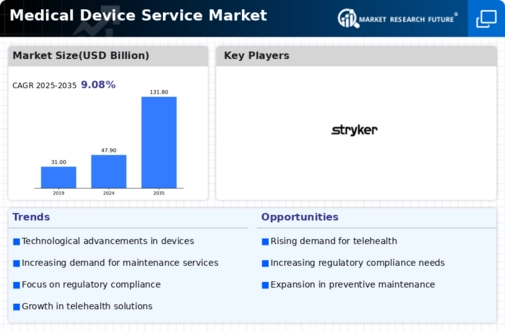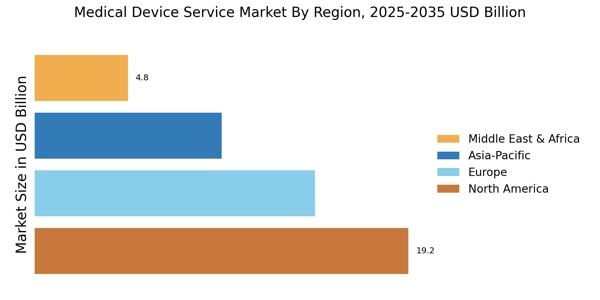Aging Population
The aging population is a significant driver of the Medical Device Service Market, as older adults typically require more medical interventions and devices. With a growing demographic of individuals aged 65 and above, the demand for medical devices, including diagnostic and therapeutic equipment, is on the rise. This demographic shift is expected to lead to an increased need for maintenance and servicing of medical devices, as older devices may require more frequent repairs and updates. According to demographic studies, the proportion of the elderly population is projected to reach nearly 20% by 2030, which will likely result in a corresponding increase in the demand for medical device services, thereby bolstering the market.
Outsourcing Trends
Outsourcing trends are reshaping the Medical Device Service Market, as many healthcare organizations seek to reduce operational costs and improve service quality. By outsourcing maintenance and repair services, healthcare providers can focus on their core competencies while leveraging the expertise of specialized service providers. This trend is particularly evident in hospitals and clinics that are increasingly relying on third-party service providers for the management of their medical devices. The outsourcing of services is projected to grow, with estimates indicating that the market for outsourced medical device services could reach several billion dollars in the next few years. This shift not only enhances operational efficiency but also allows healthcare organizations to access advanced technologies and skilled personnel.
Regulatory Compliance
Regulatory compliance remains a critical driver in the Medical Device Service Market, as manufacturers and service providers must adhere to stringent regulations set forth by health authorities. Compliance with standards such as ISO 13485 and FDA regulations is essential for ensuring the safety and efficacy of medical devices. The increasing complexity of regulatory requirements necessitates that service providers stay updated with the latest guidelines, which can be resource-intensive. As a result, companies are investing in compliance management systems and training programs to ensure adherence. This focus on regulatory compliance not only enhances the credibility of service providers but also fosters trust among healthcare professionals and patients, thereby driving market growth.
Technological Advancements
The Medical Device Service Market is experiencing a surge in technological advancements that enhance the efficiency and effectiveness of medical devices. Innovations such as artificial intelligence, machine learning, and the Internet of Things are being integrated into medical devices, leading to improved diagnostics and patient outcomes. For instance, predictive maintenance technologies are being adopted to minimize device downtime, which is crucial in healthcare settings. The market for medical device services is projected to grow significantly, with estimates suggesting a compound annual growth rate of over 10% in the coming years. This growth is driven by the need for continuous service and support for increasingly complex medical devices, indicating a robust demand for specialized service providers.
Increased Focus on Preventive Maintenance
An increased focus on preventive maintenance is emerging as a key driver in the Medical Device Service Market. Healthcare providers are recognizing the importance of maintaining medical devices to prevent unexpected failures and ensure optimal performance. Preventive maintenance strategies, which include regular inspections and servicing, are being adopted to extend the lifespan of medical devices and reduce overall costs. This proactive approach is particularly relevant in high-stakes environments such as hospitals, where device reliability is paramount. The market for preventive maintenance services is expected to expand, as healthcare organizations aim to minimize downtime and enhance patient care. This trend indicates a growing recognition of the value of comprehensive service agreements that include preventive maintenance components.


















Leave a Comment